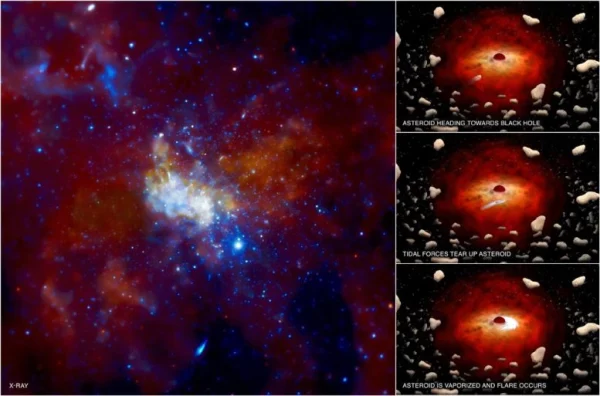The supermassive black hole Sagittarius A*, located at the center of the Milky Way, is one of the most fascinating astronomical phenomena closely monitored by scientists. Based on data from NASA’s Chandra X-ray Observatory and the Very Large Telescope in Chile, astronomers have discovered that the mysterious X-ray flares emitted by this black hole may be linked to the destruction of countless asteroids. “These flares could result from violent collisions between asteroid fragments and the hot gas surrounding the black hole,” according to a report by NASA in 2012.
Studies have shown that around Sagittarius A* exists a massive cloud containing trillions of asteroids and comets, drawn from their original orbits by the black hole’s gravitational pull. When an asteroid ventures within a distance of 100 million miles—roughly the distance between Earth and the Sun—it is torn apart by intense tidal forces. The fragments then collide with the hot gas surrounding the black hole, emitting X-ray flares before being entirely consumed by the black hole.

Notably, these X-ray flares occur with a frequency of approximately once per day and shine up to several times to hundreds of times brighter than the usual light emitted by the black hole. According to research by Kastytis Zubovas from the University of Leicester, the size of the asteroids being destroyed is typically greater than 6 miles. Zubovas noted: “We need a substantial number of asteroids in this region to account for the observed frequency and brightness of the X-ray flares.”
This discovery is not only intriguing in understanding how black holes operate but also provides clues about the formation of celestial bodies in such extreme environments. According to a report from the Chandra X-ray Observatory, during its 10-billion-year lifespan, Sagittarius A* may have destroyed trillions of asteroids, yet it continues to draw a steady supply from nearby stars.
“An asteroid’s orbit can change when it passes near a star or planet close to Sagittarius A*. If it is flung toward the black hole, its fate is sealed,” said Sergei Nayakshin, co-author of the study at the University of Leicester.
Additionally, such large-scale destruction events are not limited to asteroids. Planets are also at risk of being torn apart if they venture too close to Sagittarius A*, although this is less common due to the rarity of planets. One such event might have occurred centuries ago, causing intense X-ray light from the galactic center to reflect off surrounding dust clouds, a signature now detectable with modern telescopes.
Sagittarius A* is not only a magnificent phenomenon but also a key to unlocking our understanding of the universe’s dynamics. The destruction of asteroids serves as a stark reminder of the immense and merciless power of supermassive black holes, while simultaneously inspiring humanity to continue its journey of cosmic exploration.


HPX24h > Space > The Milky Way’s Central Black Hole: The Asteroid Annihilator
Top Reads from This Category
Space
Over 100 Billion Planets in the Milky Way: Astonishing Discoveries About the Universe
Space
18 New Planets: Unlocking the Gateway to Exploring Giant Star Systems
Space
3D Lunar Map: A New Gateway to Understanding the Universe
Space
Habitable Exoplanets: Exploring Distant Worlds
Space
Jupiter-Like Planets: The Key to Unlocking Earth-Like Worlds
Space
The Two Largest Black Holes Ever Discovered
Space
Scientists Discover Dark Galaxy Located 10 Billion Light-Years from Earth
Discover New Topics
Fitness
Mastering the Difference Between Aerobic and Anaerobic: Are You Choosing the Right Workout
Fitness
Secrets to Building Muscle with Exercise: From Technique to Habit Maintenance
Fitness
Safe Exercises for Early Pregnancy: Tips to Keep Moms Healthy and Strong
Animals
Rats Help Each Other: When Compassion Emerges from Small Creatures
Animals
Why Bedbugs Thrive Through Inbreeding
Science
Artificial Intelligence Outperforms Humans in Treating Depression
Parenting Tips
How to Talk to Your Child About Divorce: Helpful Tips for Parents
Healthy Eating
How to Follow the 5:2 Diet: The Key to Effective Weight Management
Health
Step-by-Step Guide to Safely Relieving Bloating in Children
Health
5 Essential Things Every Woman Should Know About Menopause
Healthy Eating
Why Do We Need Fiber in Our Diet?
Healthy Eating
Essential Nutrition: The Golden Key to Comprehensive Health
Healthy Eating
Foods That Support Depression Reduction: The Latest Scientific Nutritional Choices